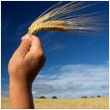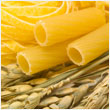Agricultural Products:
Grains and Oilseeds > Wheat
Non-durum and durum wheat
 Overview Overview  Durum Wheat Durum Wheat
Overview
Canadian wheat, widely considered the best quality grown wheat in the world. Fertile soil conditions, cleanly environment in which to thrive, virtually no contaminants or air quality influences. Quality input always results in quality output, regardless of the application.
 For 2007-2008, world production is forecast to increase by 4% to a near-record 617 Mt. Supply is also forecast to increase but higher production will be partly offset by lower carry-in stocks. Wheat consumption is forecast to increase slightly due to greater non-feed use. World wheat carry-out stocks are expected to fall by 6% from the previous year, to 113 Mt, with the stock-to-use (s/u) ratio at a record low of 18%. Trade is expected to remain near the 2006-2007 level of 110 Mt. For 2007-2008, world production is forecast to increase by 4% to a near-record 617 Mt. Supply is also forecast to increase but higher production will be partly offset by lower carry-in stocks. Wheat consumption is forecast to increase slightly due to greater non-feed use. World wheat carry-out stocks are expected to fall by 6% from the previous year, to 113 Mt, with the stock-to-use (s/u) ratio at a record low of 18%. Trade is expected to remain near the 2006-2007 level of 110 Mt.
Non-durum wheat production is forecast to increase by 4% in 2007-2008, to about 581 Mt, with world trade forecast to be relatively unchanged at 103 Mt, slightly above the 10-year average. For 2006-2007, Non-durum wheat production rose by 12% in 2006, to 23.5 Mt, as a result of the largest seeded area since 1997, including record winter wheat production in Ontario.
Western wheat quality was much better than normal, with over 90% of the Canada Western Red Spring (CWRS) crop grading No.2 or better. As a result of increased supplies of better quality wheat, exports in 2006-2007 are projected to increase by over 30%, to 15.0 Mt (including products), the highest since 1997-1998.
Wheat prices in world markets have strengthened significantly in 2006-2007, as a result of smaller crops and reduced exportable supplies in all major exporting countries except Canada.
Durum Wheat
Durum wheat is a wheat specialty.
 Durum wheat (Triticum durum) has unique characteristics making it specialty wheat in world wheat markets. The substitutability of common wheat (t. aestivum) for durum wheat is therefore limited, while durum is unsuited for many of the products produced from common wheat. The major durum products are pasta and couscous, a staple food in North Africa. Good quality durum has a very hard vitreous (glassy) kernel (HVK), with an amber yellow endosperm, while common wheat, even hard red spring wheat, is less vitreous and has a white endosperm. Durum pasta maintains a firm texture when cooked, and its natural amber colour is associated with good quality pasta. Durum wheat (Triticum durum) has unique characteristics making it specialty wheat in world wheat markets. The substitutability of common wheat (t. aestivum) for durum wheat is therefore limited, while durum is unsuited for many of the products produced from common wheat. The major durum products are pasta and couscous, a staple food in North Africa. Good quality durum has a very hard vitreous (glassy) kernel (HVK), with an amber yellow endosperm, while common wheat, even hard red spring wheat, is less vitreous and has a white endosperm. Durum pasta maintains a firm texture when cooked, and its natural amber colour is associated with good quality pasta.
It should be noted that Asian-style noodles are made from common wheat, not durum. In Europe and North America, pasta products (spaghetti, macaroni, etc.) are generally produced exclusively from durum semolina, although other countries traditionally have used common wheat or durum blends to produce pasta.
New production technology, such as high temperature drying, has improved the quality of pasta that can be made from common wheat, but discriminating pasta consumers continue to prefer pasta made from 100% durum wheat. In North Africa, durum is preferred for the production of couscous. While durum is also used for bread production in some countries, particularly North Africa, this usage is quite limited in terms of total world durum utilization. (Agri-Canada)
Durum wheat production in 2007-2008 is forecast by the International Grains Council (IGC) to rise to 36 Mt, similar to the 10-year average, mainly due to increased production in the US and Canada. World trade is expected to rise to 6.9 Mt from 6.8 Mt in 2006-2007. Durum prices have risen sharply in 2006-2007 due to lower production in the major exporting countries, particularly the US and Canada, which more than offset increased production in the major importing region, North Africa. (Agri-Canada)
CanAsia Trade is your source for Canadian quality non-durum and durum wheat product.
|